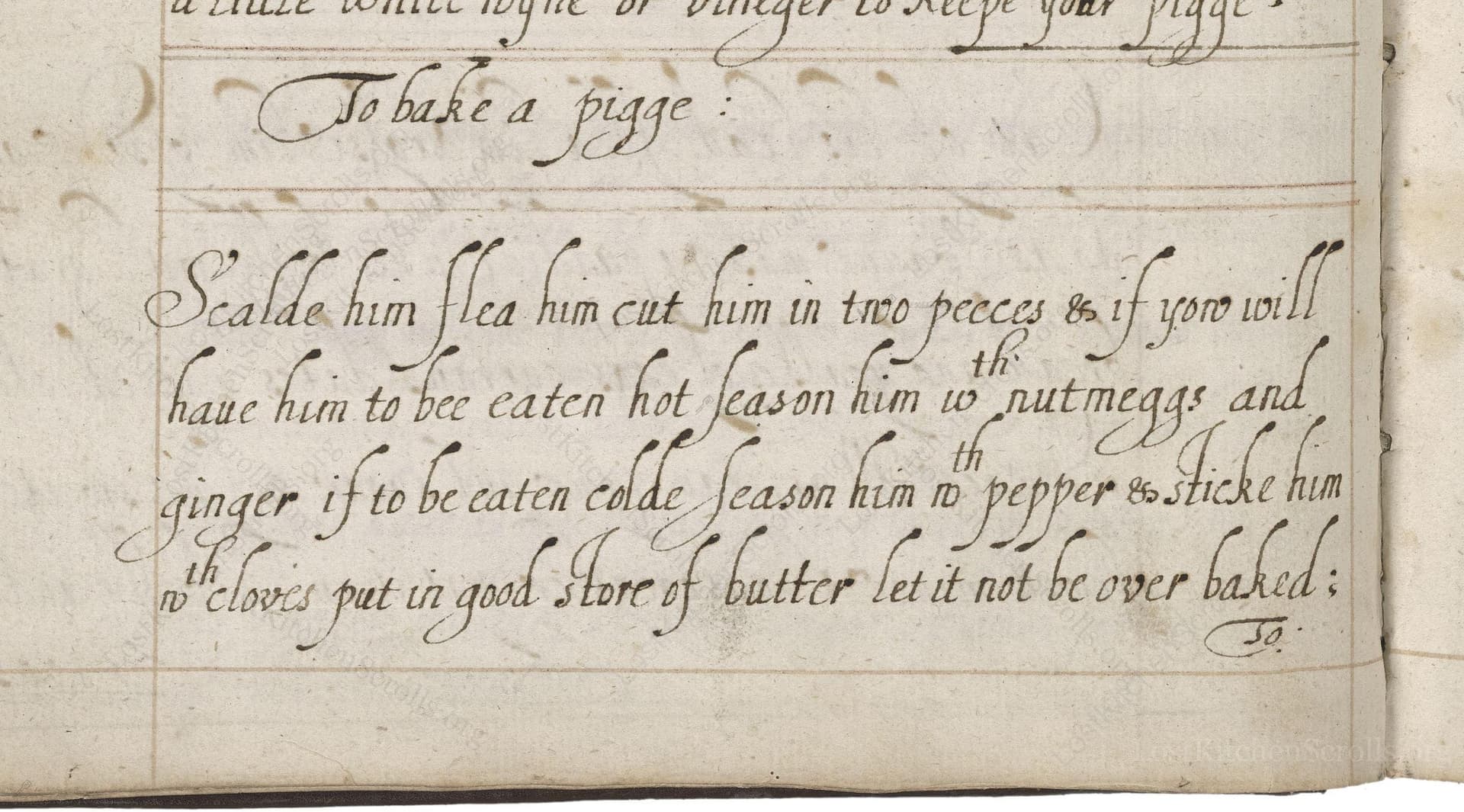To Bake A Pigge
From the treasured pages of Medicinal and cookery recipes by John King
Written by John King

To Bake A Pigge
"Scalde him flea him cut him in two peeces & if yow will have him to bee eaten hot season him wth nutmeggs and ginger if to be eaten colde season him wth pepper & sticke him wth cloves put in good store of butterr let it not be over baked."
Note on the Original Text
The recipe is written in the direct, minimalist style typical of the early 17th to 18th centuries, omitting precise measurements or times, assuming a cook's familiarity with kitchen processes. The spelling reflects early modern English conventions: 'scalde', 'flea' (flay/skin), 'peeces', and 'yow' (you). Clarity was aimed for the experienced housewife or cook, with ingredients and method bundled together in sequence—the norm for most manuscripts of the time.

Title
Medicinal and cookery recipes by John King (1675)
You can also click the book image above to peruse the original tome
Writer
John King
Era
1675
Publisher
Unknown
Background
A delightful journey into the kitchens of the 17th and early 18th centuries, this collection, attributed to John King, brims with time-honored recipes, culinary wisdom, and flavors that once graced historic tables.
Kindly made available by
Folger Shakespeare Library
This recipe originates from the early modern English period, roughly between 1625 to 1725, as found in a collection associated with John King. During this era, pig—particularly the young, tender pig—was a delicacy often reserved for feasts or special occasions. The choice of seasoning reflects the period’s fascination with imported spices and their versatile, status-signaling roles at table. Such recipes bridge the transition from medieval to more modern British cookery, balancing tradition and new culinary influences.

In its original context, the suckling pig would have been prepared using basic but sturdy kitchen tools: a large cleaver or knife for butchering, an iron or earthenware roasting pan, and a spit or open hearth oven for roasting. Butter may have been churned fresh, and spices ground by hand with a mortar and pestle. An impressive kitchen fire would have helped ensure the right heat for roasting without drying the meat.
Prep Time
30 mins
Cook Time
3 hrs
Servings
10
We've done our best to adapt this historical recipe for modern kitchens, but some details may still need refinement. We warmly welcome feedback from fellow cooks and culinary historians — your insights support the entire community!
Ingredients
- 9-11 lbs suckling pig (or substitute with pork shoulder for similar results)
- 0.2 oz (about 1 tbsp) freshly grated nutmeg
- 0.35 oz (about 2 tbsp) ground ginger
- 0.35 oz (about 2 tbsp) ground black pepper
- 15 whole cloves
- 7 oz unsalted butter
Instructions
- Begin by thoroughly cleaning a suckling pig (about 9-11 lbs).
- Scald the skin with boiling water, then remove the hair.
- Cut the pig into two halves.
- If serving hot, season the flesh generously with freshly grated nutmeg and ground ginger.
- For a cold dish, instead season it with black pepper and stud the meat with whole cloves.
- Place the halves in a roasting pan and add plenty of butter—approximately 7 oz.
- Roast in a preheated oven at 320°F, basting occasionally, and take care not to overcook the meat so it remains moist and tender.
- Serve hot or cold, as preferred.
Estimated Calories
600 per serving
Cooking Estimates
Preparation takes about 30 minutes for cleaning, seasoning, and prepping the pig. Roasting takes around 3 hours to make sure the meat stays moist and tender. Each serving is based on a portion from a 4-5 kg pig, which is usually enough for 10 people. Each serving has around 600 calories, mostly from the pork and butter.
As noted above, we have made our best effort to translate and adapt this historical recipe for modern kitchens, taking into account ingredients nowadays, cooking techniques, measurements, and so on. However, historical recipes often contain assumptions that require interpretation.
We'd love for anyone to help improve these adaptations. Community contributions are highly welcome. If you have suggestions, corrections, or cooking tips based on your experience with this recipe, please share them below.
Join the Discussion
Rate This Recipe
Dietary Preference
Main Ingredients
Culinary Technique

Den Bockfisch In Einer Fleisch Suppen Zu Kochen
This recipe hails from a German manuscript cookbook compiled in 1696, a time whe...

Die Grieß Nudlen Zumachen
This recipe comes from a rather mysterious manuscript cookbook, penned anonymous...

Ein Boudain
This recipe comes from an anonymous German-language manuscript cookbook from 169...

Ein Gesaltzen Citroni
This recipe, dating from 1696, comes from an extensive anonymous German cookbook...
Browse our complete collection of time-honored recipes



